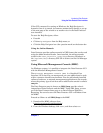
Introducing Data Protector
Overview of Tasks to Set Up Data Protector
Chapter 1 15
Overview of Tasks to Set Up Data Protector
Although configuring Data Protector is easy, some advanced planning
will help you configure the environment and optimize your backups. This
section provides an overview of the global tasks to set up a backup
environment.
Depending on the size and complexity of your environment, you may not
need to go through all these steps.
1. Analyze your network and organizational structure. Decide which
systems need to be backed up.
For more information refer to the HP OpenView Storage Data
Protector Concepts Guide.
2. Check whether there are any special applications and databases
which you want to back up, such as Microsoft Exchange, Microsoft
SQL, Oracle, SAP R/3, or others. Data Protector provides specific
integrations with these products.
Refer to the HP OpenView Storage Data Protector Integration Guide
for instructions on how to configure the integrations.
3. Decide on the configuration of your Data Protector cell, such as the
following:
• System to be your Cell Manager
• Systems on which you want to install the user interface
• Type of backup - local backup versus network backup
• Systems to control backup devices
4. Purchase the required Data Protector licenses for your setup. This
way you obtain the passwords you need to have installed.
Alternatively, you can operate Data Protector using an instant-on
password. However, this is valid only for 60 days from the date of
installation. Refer to the HP OpenView Storage Data Protector
Installation and Licensing Guide for details.
5. Decide how you want to structure your backups:
• Which media pools would you like to have, and how will they be
used?


















